| |
John Stewart, Photographer.
|
|
John Stewart was a friend of Charlotte Bronte's publisher, George
Smith. In the 1850s Stewart was a keen experimental photographer and Smith
arranged for him to visit Haworth Parsonage to photograph George Richmond's portrait of
Charlotte.
John Stewart (1814-87) abandoned photography about 1860. He is not the
photographer of the same name operating in Scotland in the 1860s-80s.
|
|
The Stewart family &
Charlotte Bronte's publisher.
|
|
John Stewart's family were linked to Smith, Elder & Co. (Charlotte
Bronte's publisher), in three different ways:
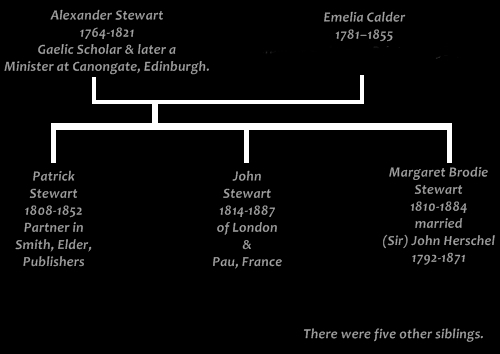
John Stewart and Alexander Elder Murray had
been partners in Stewart & Murray, printers, London (1838-41). The printers did a great deal of
work for Smith, Elder who acquired it in 1855.
John's brother, Patrick Stewart, was a partner in Smith,
Elder & Co., but in 1848 it was discovered that he had been defrauding them. The sums
involved were enormous, over £30,000, and the fraud nearly destroyed the publishers.
Patrick Stewart continued to work for Smith, Elder & Co. for two years before moving
to India where, it is said, that he committed suicide in 1852.
1.
John's sister, Margaret Brodie Stewart married the famous
astronomer and photographic pioneer, Sir John Hershel. Although Hershel wasn't involved
in the running of the publishers he had large sums invested in it. Hershel' s book
'Astronomical Observations made at the Cape of Good Hope' was published in
1846 by Smith, Elder & Co., about the same time as they published Charlotte
Bronte's 'Jane Eyre'. Herschel was sent one of the first copies of Charlotte's novel
and he became one of the first Jane Eyre fans.
|
|
Edinburgh, London, Nantes
& Pau.
|
|
John Stewart's family moved from Edinburgh to London, probably about 1830, and
he formed a partnership with Alexander Elder Murray, creating Stewart & Murray, printers about
1838. John married Matilda Grahame, daughter of James Grahame (1790-1842) of Nantes, France in July, 1839 and amongst
those who travelled there for the ceremony was his brother-in-law, John Herschel.
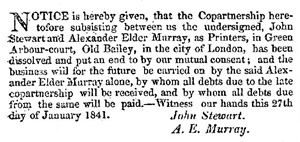
Stewart left the partnership in the printing company in 1841, moved to live in
Nantes and then, about 1846, to Pau in the Midi Pyrenees. He spent time in France and England.
1850s
In the 1850s, he took up photography and joined a group of artists which became
known as l'École de Pau. The photographers included Henri Victor Regnault, Jean-Jacques Heilmann, Farnham Maxwell-Lyte, Louis Désiré Blanquart-Evrard & Pierre Langlumé. More biographical
information on the Luminous Lint website.
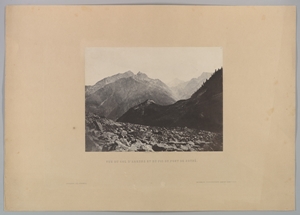
View of the Arruns Pass and Peak from the Pont de Soubé,
Midi-Pyrénées, France.
One of several views by John Stewart.
(Metropolitan Museum of Art, New York)
1853-56
In 1853 John Stewart toured parts of England with Henri
Victor Regnault. Photographs were taken of Bodiam Castle, Peterborough Cathedral and at Hawkhurst village, when they visited John Herschel.
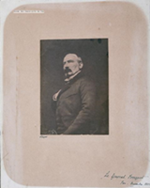
Photo by John Stewart: "Le Général Bosquet, Pau-Décembre
1855"
© Le Musée des Beaux-Arts de
Pau.
It is thought that Stewart spent about four weeks in June & July
1855 taking photographs in Iceland. By December 1855 he had
returned to his family in France because a photograph exists of Le Général Bosquet (1810-61),
signed by John Stewart, with the title: "Le General Bosquet, Pau, Decembre
1855".2.
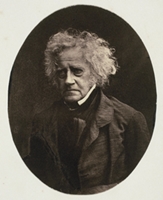
Photograph of John Herschel by his
brother-in-law, John Stewart at the National Gallery of
Canada.
An article published in May 1856 describes a book,
"The Photographic Album for the year 1856; being contributions from the members of the
Photographic Club," a copy of which was presented to Queen Victoria and included John
Stewart's portrait of Sir John Herschel. 3.

Stewart was a founder member of Pau Golf Club (1856) and
there is a website (in French) with some information on him: Pages 28-32,
Pau Golf Club 1856 WHO'S WHO 1856-1962 par Raphaël Rossoni - Edition
Décembre 2015. There is a photograph of him on the Pau Golf Club website.
|
|
John Stewart, Arthur
Nicholls & Elizabeth Gaskell.
|
|
In the winter of 1856-7 John Stewart was in England and Smith &
Elder had a problem. This was a year after Charlotte Bronte's death and Elizabeth Gaskell was
writing a biography which was to be published by them. She wanted the 'Richmond Portrait' of
Charlotte copied as a photograph so that an engraving could be made for the frontispiece.
Originally, Charlotte's widower, Arthur Nicholls refused permission but later relented under
pressure from Gaskell's friend, the overbearing Sir James Kay-Shuttleworth. Gaskell was going to
commission a Manchester photographer to do this but it seems Mr Nicholls didn't trust her. Instead,
Nicholls arranged (through Smith, Elder & Co.) for John Stewart to carry out the work.
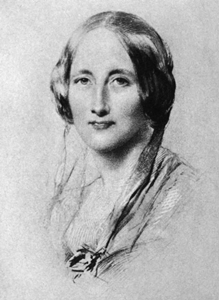
In a letter (early Nov 1856) to George Smith, Elizabeth Gaskell writes:
“Mr Stewart is a first rate amateur photographer; gone out to Iceland by
Danish Government’s request to take boiling springs and those sort of things,- has had to go
and show his photographs to the Queen, as the ‘crackest’ things of the kind in the Kingdom, so
I think he’ll do it well-& should he not take the view of house & village & moors
beyond? I know a very good view (drawing) very characteristic."
The Letters of Mrs Gaskell (no.317)
For some unknown reason Stewart made two visits Haworth
in 1856.4.
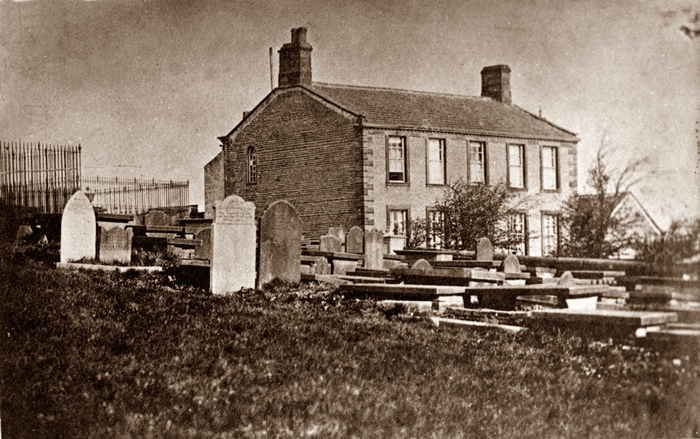
Even before the biography had been suggested Gaskell had wanted a photograph of
the 'Richmond Portrait' as a keepsake. When John Stewart visited Nicholls he was "under a
solemn promise" to make just three copies; one was to go to the publishers to be engraved and
the other two were to be returned to him.
|
|
1857
|
|
Late January or early February 1857 Stewart made a third visit to Haworth, this
time to take some views of Haworth Village, Church & Parsonage for Mrs Gaskell. These would be
a selection of views which Gaskell could choose from to be used as an engraving for the
biography.
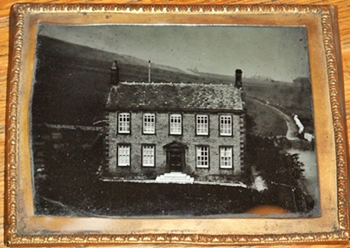
We believe that the photo at the Bronte Museum, of the Parsonage viewed from the
Church Tower (above), is one of these views. It is not known how many photos Stewart took
but he sent three to Elizabeth Gaskell.
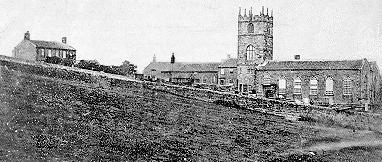
Mrs Gaskell wanted a photo to show the Parsonage and Church but was disappointed
with the result because the Parsonage appeared too small (as in the above photo). Hardly the
photographer's fault that the buildings are not closer together! On 4 February 1857, Gaskell
forwarded the three photos to the publisher, George Smith:
"The views disappoint me a little; but he is very good to have taken so
much pains about them. They give an idea of wildness and desolation; but not of height and
steepness, & of the fine sweeping moors beyond. The Parsonage is that square house by
itself to the\behind/left of the church-very faint in all owing to the distance."
The Letters of Mrs Gaskell (no.338)
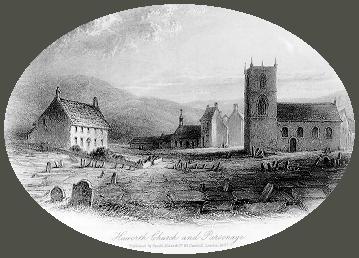
In the end Gaskell decided not to use the landscape photographs and
sent one of her own sketches to be engraved (above) for the frontispiece.
Artistic license allows the Parsonage to be larger and closer.
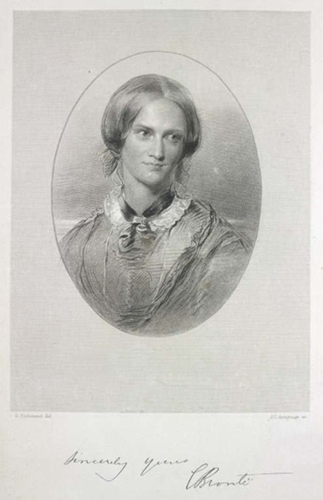
The photographic copy of the 'Richmond Portrait' was used to create the
engraving (above) enabling the public to see Charlotte Bronte for the first time. Elizabeth
Gaskell's biography The Life of Charlotte Brontë was published in March 1857.

After John Stewart had sent the photographs of Haworth to Mrs
Gaskell his work was done and at some point after this he returned to his home
in Pau, France. In February 1857, on completion of the biography of Charlotte Bronte, Mrs
Gaskell left Manchester to stay in rue du Bac, Paris, and visited Mary Clarke Mohl. She visited Mary at her famous literary salon on several
occasions over the years. 5.
John Stewart's photograph of his brother in law, John Hershel, was exhibited at
the Manchester Art Treasures Exhibition in October 1857; this would have
been a print on paper.
|
| |
|
1. Patrick Stewart emigrated to India c1850. This could
be because his brother Dr Duncan Stewart worked for the East
India Company in Calcutta. The 'suicide' of Patrick Stewart in Calcutta may
actually have taken place on board a ship. No report yet found other than
notices in newspaper death columns published several weeks later.
"DEATHS: At sea, on the 30th January, on board the Lord Ellenborough, on
his way from Calcutta, Patrick Stewart, Esq., fifth son of the late Rev Dr Alexander Stewart,
Edinburgh. " Dundee, Perth, and Cupar Advertiser - Tuesday 13
April 1852.
The "Lord Ellenborough" seems to be an
error. It was probably "The Ellenborough" which transported soldiers and stores to
Calcutta from c1846. Possibly the same ship was used to transport emigrants from Southampton,
England, to Australia c1854 - see these external websites here & here.
2. Illustrated London News
- Saturday 03 May 1856, p.475 reports on the publication of The Photographic Album
for the year 1856; being contributions from the members of the Photographic Club.
“The biographers describe in very enthusiastic
language the beauties of a folio volume of fifty photographs by fifty different hands, and
those of eminence, to which Mr. Whittingham, of Chiswick, has attached fifty pages of
letterpress of corresponding beauty. The volume is a
present to her Majesty, and is one of fifty-two copies of series of photographs made by the
members of the Photographic Club—a newly-established club akin to the old Etching Club, and
instituted to advance and record the progress of the art of photography.
This is their first volume, and most
wonderfully does it exhibit the progress which photography has made in England during the past
year. Each of the fifty members sends fifty-two impressions of what he considers to be his best
photograph with a description of the process used in obtaining it. Fifty copies are distributed
among the fifty; the fifty-first is offered to her Majesty, and the
fifty-second presented to the British Museum.
Very wonderful, indeed, are some of the
photographs this very beautiful volume. We would especially point out as perfect in their truth
to nature and adherence to art Mr. Batson’s “Babbicombe Bay,” Mr. Henry Taylor’s “Lane Scene,”
Mr. Llewellyn’s “Angler,” Mr. Bedford’s ‘‘Flowers,” Mr. Delamotte’s “Innocence,” Dr. Diamond’s
“Interior of Hollyrood,” Mr. Henry Pollock’s Windsor Castle," Mr. Mackinlay’s “Bodiham Castle,”
Mr. White’s “Garden Chair,” and Mr. John Stewart’s appropriate vignette to the volume
—the portrait of Sir John Herschel.“
3. A John Stewart
returned from Iceland in July, 1855; there was also a Mr R. M. Smith, possibly related to George
Murray Smith.
"EDINBURGH ----THE THOR.-This Danish
man-of-war steamer returned to the Roads on Tuesday night after a month's cruise to Iceland and
the Faro Islands. The passengers on board of her, from this, were Messrs Alexander and Robert
Allan, Mr Robert Chambers, Mr John Stewart, Mr R. M. Smith, and Mr Laurie - and we understand
they have had a highly agreeable and successful trip. The Thor sailed for Copenhagen this
forenoon." Caledonian Mercury, Friday 20th July 1855
Iceland was a part of the Kingdom of Denmark from
1814 to 1918 and "The Thor" was a screw corvette built for the Danish Navy. Robert Allen read a
paper "Geysers in Iceland" at the meeting of the British Association for the Advancement of
Science, Glasgow, September 1855.
4. No mention of a photo of the Bronte sisters has been found
in Gaskell's letters. Stewart sent a photograph of the Richmond portrait of Charlotte to
Gaskell, received by 11 November 1856. He was kept waiting by Mr Nicholls on this first visit.
For some unknown reason he returned to Haworth (before 6 Dec 1856). On a third visit he took
photographs of Haworth village, Church & Parsonage; he sent three to Gaskell, received by 4 Feb
1857.
5. Elizabeth Gaskell, her two elder
daughters & Catherine Winkworth visited Paris and then Rome.
|
|
|

